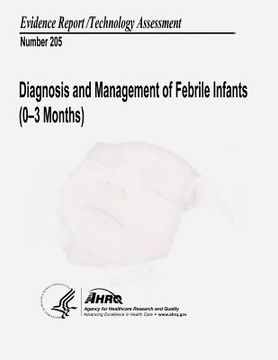Diagnosis and Management of Febrile Infants (0-3 Months): Evidence Report/Technology Assessment Number 205 (en Inglés)
Reseña del libro "Diagnosis and Management of Febrile Infants (0-3 Months): Evidence Report/Technology Assessment Number 205 (en Inglés)"
The febrile infant is a common clinical problem that accounts for a large number of ambulatory care visits. Young febrile infants (ages 0-3 months) often present with nonspecific symptoms and it is difficult to distinguish between infants with a viral syndrome and those with early serious bacterial illness (e.g., meningitis, bacteremia, urinary tract infection (UTI), and pneumonia). The definitions of serious bacterial illness (SBI) vary across published literature. SBI typically includes the diagnoses of meningitis, bacteremia, and UTI. Some studies have also included pneumonia, bone and joint infections, skin and soft tissue infections, and bacterial enteritis in the definition. Invasive herpes simplex virus (HSV) infections are grouped into meningoencephalitis; disseminated; or skin, eyes, and mouth. There is some overlap in these presentations. Febrile illness in infancy is often due to viral infections and is likely to be self-limiting. Although SBI is relatively uncommon among febrile infants, if it is not promptly diagnosed and managed, serious consequences may result. The clinical dilemma that practitioners often face is how to avoid missing a case of SBI versus how to avoid the risks and harms of investigating, observing, and potentially treating a febrile infant with no SBI. The most common bacterial pathogen for SBI in the young infant is Escherichia coli, with Group B Streptococcus, Staphylococcus aureus, Listeria monocytogenes, and other gram-negative enteric bacteria being the other likely pathogens in this age group. Although uncommon, HSV infections are a major cause of morbidity and mortality among neonates (ages 0-28 days) with a case fatality rate of 15.5 percent. The prevalence of neonatal HSV infection has been reported to be between 25 and 50 per 100,000 live births in the United States. The prevalence of HSV infection in a febrile neonate is 0.3 percent which is similar to the prevalence of bacterial meningitis in this age group. Historically, febrile infants less than 3 months of age would undergo a complete evaluation for sepsis, including a lumbar puncture, and would be admitted to a hospital for intravenous antibiotics for at least 48 hours pending culture results. The rationale for this approach is based on the high prevalence of SBI in this group and the difficulty with the clinical assessment for sepsis in the young infant where clinical signs of sepsis are often subtle. Although this approach minimizes the risk of infectious complications, it leads to unnecessary hospitalization and treatment, resulting in potential iatrogenic harms to infants. In recent decades, increasing awareness of these trade-offs has led to efforts to discriminate better which young infants with fever might really need more versus less intensive management. Technical advances have been part of the impetus. The recommended management of febrile neonates, infants under 28 days of age, is controversial. Given that the overall prevalence of SBI is higher in the neonate, most experts would advocate for a full sepsis evaluation and hospitalization. There are studies that have attempted to apply low-risk criteria in infants less than 1 month of age but because of the higher baseline rates of serious bacterial illness in the neonate the overall rates of SBI in the low-risk group are higher than in older infants. The current recommendations for the evaluation and management of the young febrile infant are based on studies conducted in the late 1980s and early 1990s. An up-to-date systematic review of the diagnostic tests and harms of the management strategies for febrile infants is warranted. This evidence report is designed to review the literature to answer Key Questions (KQs) about the management of the febrile infant and to identify needs for future research.

